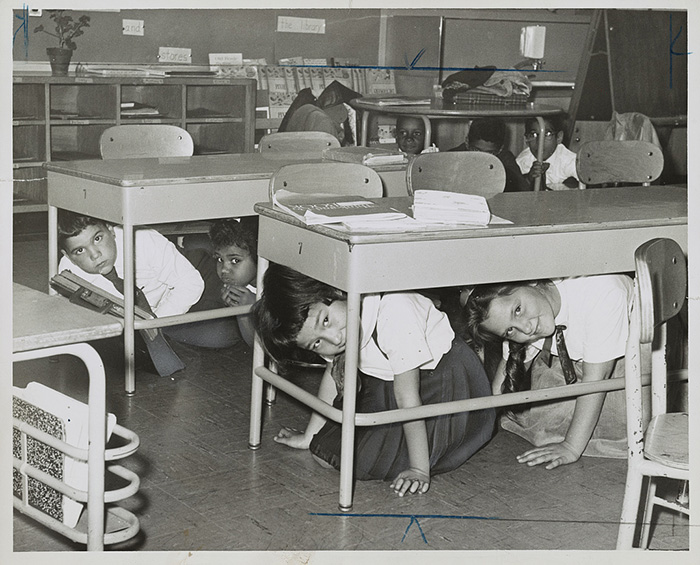Book explores why schools stick to 'Duck and Cover' policies that don't work

LAWRENCE — In American schools of the 1950s and ‘60s, students were taught to dive under their desks, crouch with their knees near their chests and to cover their heads with their hands. These “duck and cover” drills were intended to teach children how to protect themselves in the event Russia — the United States’ Cold War rival — dropped an atomic or nuclear bomb near a school.
“Every kid in America knew this was ridiculous. There was no way a desk was going to save you from the bomb,” said Rick Ginsberg, dean of the University of Kansas School of Education & Human Sciences. “It was arguably the stupidest thing ever done in American education.”
Yet the practice persisted. Likewise, many educational practices exist today that originated from good intentions but are ineffective or even harmful. Such policies are the target of the new book “Duck and Cover: Confronting and Correcting Dubious Practices in Education.” The book, by Ginsberg and Yong Zhao, Foundation Distinguished Professor of Education at KU, examines several educational policies still used in schools despite their ineffectiveness.
Just as the original duck-and-cover policy was implemented because leaders wanted to do something in the face of a threat, most practices originate in schools to help students, boost “failing” schools or answer other concerns. Ginsberg and Zhao examine more than a dozen such policies and practices in the new book, published by Teachers College Press.
“Duck and Cover” is divided into three parts, beginning with “Dreams, Fantasies and Nightmares.” The authors examine topics including kindergarten readiness, reading proficiency by third grade, social and emotional learning, foreign language instruction and educational technology. Each chapter explores policy origins, goals and why they do not work.
“These policies were laid out as dreams, but really they’re nightmares. They don’t work,” Zhao said. “We want policymakers and leaders to sit down and think about what we want our educational policies to do. In the case of technology, we spend massive amounts of money, but it has never truly changed teaching or results. We’re not against technology, but we need to get something for our investment.”
For each chapter, the authors offer what they call the new three R's: revise, reconsider or replace. The authors also provide a “Duck and Cover audit guide” to evaluate policies and determine which route is best.
Part II of “Duck and Cover” addresses “Operational Bugaboos,” including professional development, class size, dressing and grooming codes, teacher evaluation, and gifted and exceptional education. Part III breaks down “Systemic and Analytic Conundrums” such as state standardized testing, governance by school board, how teachers are paid and meta-analysis.
Unlike the original duck-and-cover policies, many practices have been in place longer than living memory. Governance by school board is one example. However, the authors wrote, because of low voter turnout for school board elections, those elected may lack an educational background and tend to serve voters before school clients. Ginsberg and Zhao acknowledged it is not necessarily realistic or practical to do away with school boards. But as an example of their three R''s analysis, the authors suggested boards could be improved with measures such as adding educators, community members and even student voices to the decision-making process.
The authors noted that they are on the side of school improvement and understand the desire to try new ways to help students. However, when practices aren’t working, something needs to be done. Much as in science, which is built on the concept of trial and error, if a school policy or approach isn’t effective, why allow it to persist? This process requires data and feedback, and that is the essence of “Duck and Cover.” But it requires asking hard questions about policies and practices.
“Yong and I have been talking for years about things we do in education that are ineffective or even stupid. Maybe they were started for good reasons, maybe not,” Ginsberg said. “Maybe it was for political reasons, but whatever the cause has lost its shelf life. All we’re asking is that you put some thought behind it.”
The authors also point out how “panacea thinking” — or the idea that a miraculous new idea can solve all problems — too often drives educational thinking. And while policymakers and politicians often push new approaches to win office, “Duck and Cover” is not political, as many of the ideas they examine were born with bipartisan support, Zhao said.
Policymakers are one intended audience, but the authors say parents, school leaders, educators and others could appreciate “Duck and Cover” and the conversations it is intended to foster. Instead of hiding out under a piece of classroom furniture or trying to avoid metaphorical fallout from educational practices, Ginsberg and Zhao wrote, it is time to ask why our schools do things the way they do and if there is value to continue doing so.
Top image: Students take part in a "duck and cover" drill in a Brooklyn school, circa 1962. Credit: Walter Albertin, Wikimedia Commons.